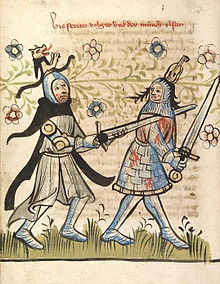Half sword
The half sword describes the middle area of a long sword , i.e. the area around the middle of the blade. Today the term is half-sword generally synonymous for leadership manner in which the left hand from the handle to the blade center (the half Sword changes). Initially, it was often resorted there with the left thumb toward blade tip lying, but since the early 15th century. Sat down generally the fingering with left thumb direction booklet by. The contemporary term for this style of leadership was fencing with the short sword , as the weapon was shortened.
This fighting technique was particularly widespread from the 14th to the 16th century in order to be able to carry out stronger strikes against armored and unarmored opponents.
The half-sword was used both to gain greater leverage in hand-to-hand combat and to be able to strike more forcefully and accurately. Both can be decisive when fighting in plate armor, as a cut or blow with a sword on iron or steel is almost ineffective. Most medieval treatises show fighting in armor primarily in the form of the “short sword” style: The best chance against a heavily armored opponent is with a hard hit in poorly protected areas such as the inside of the joints, visor slots or gloves. Attacking these areas against someone who was already lying on the ground became even more effective, which is why a large part of the techniques in half-sword combat consists of lever and throwing techniques. Some weapons ( armor combat swords ) were specially modified for this purpose and equipped with a ricasso in the middle of the blade. Some long swords only have a short ricasso , which is too close to the crossguard to be used for the half sword technique. With the later two-handed swords , the ricasso in front of the crossguard was longer, so that the fighter had a large grip surface. With these weapons, however, you put your right hand on the ricasso, which is particularly advantageous in the fight against polearms and should not be confused with half-sword fighting in armor.
A special technique in fighting in a short sword / half sword with both hands on the blade was the so-called Mordhau .
Web links
- Half sword at schwerteln.de
- Description of the Ringeck half sword (1440)
- Description of a technique by Peter von Danzig (99r)
Individual evidence
- ↑ Glossary of historical fencing s. P. 8 under "stand armed" and "half sword"
- ↑ medieval fencing book ( memento of the original from December 5, 2010 in the Internet Archive ) Info: The archive link was automatically inserted and not yet checked. Please check the original and archive link according to the instructions and then remove this notice. under "Von Durchwechsel" and there "Kampfstuck"
- ^ Achille Marozzo: Opera Nova. ( Memento of the original of June 21, 2010 in the Internet Archive ) Info: The archive link was automatically inserted and not yet checked. Please check the original and archive link according to the instructions and then remove this notice. PDF; 15.2 MB. 1536, sheet 78 verso

